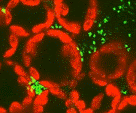Plant Pathology, Department of

Department of Plant Pathology: Faculty Publications
Document Type
Article
Date of this Version
1-2006
Citation
Published by The American Phytopathological Society, January 2006, Volume 90, Number 1, Page 108 http://dx.doi.org/10.1094/PD-90-0108C
Abstract
Smooth bromegrass (Bromus inermis Leyss.) is the most common perennial grass species cultivated for forage in North America. During late fall of 2004, smooth bromegrass plants in Lincoln, NE were observed to have brown lesions on leaf midveins that were several centimeters long. Symptomatic leaves were surface disinfested for 1 min in 2% NaOCl and incubated at 25°C on potato dextrose agar (PDA) and water agar. The fungus, Pithomyces chartarum (Berk. & Curt) Ellis, was isolated consistently and identified on the basis of morphological characteristics (1). Colonies were effused and black on PDA. Conidiophores measured 3.5 to 8 × 1.9 to 3.9 μm and were smooth and single. Conidia (7 to 25 × 9.5 to 14 μm) were broadly ellipsoidal, pale brown to dark brown, verrucose with mainly three transverse septa and one to two longitudinal septa. Pathogenicity tests were conducted on 50-day-old plants by spraying with a conidial suspension (2.5 × 105 spores per ml). Control plants were sprayed with sterile water. All plants were kept in a moist chamber (100% relative humidity) for 3 days and then transferred to a greenhouse (25°C, >70% relative humidity, and a 12-h photoperiod). One week after spraying, elongated lesions developed on leaf midveins of inoculated plants from which P. chartarum was consistently reisolated. No symptoms were observed on control plants. While P. chartarum has been described as a saprotroph or a parasite on a wide range of plants primarily in the tropics and subtropics, including the southern United States (2), it was reported previously on B. inermis only in Canada (3). This report expands the distribution and host range of P. chartarum as a pathogen in the United States.


Comments
Open Access.